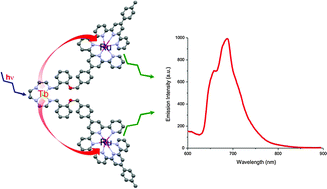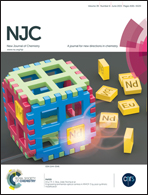A new heterometallic terbium(iii)–ruthenium(ii) complex and its terbium(iii)–zinc(ii) analog: syntheses, characterization, luminescence, and electrochemical properties†
Abstract
Synthesis of a d–f heterometallic trinuclear complex [Tb(NO3)2(L2){Ru(ttpy)}2](PF6)5 (6) (L2 = N1,N2-bis(2-((Z)-2-(4-(2,2′:6′,2′′)-terpyridin-4′-yl-benzyloxy)benzylideneamino)ethyl)ethane-1,2-diamine; ttpy = 4′-tolyl-2,2′:6′,2′′-terpyridine) and intramolecular energy transfer from terbium(III) to ruthenium(II) at room temperature are reported. 2-(4-(2,2′:6′,2′′)-Terpyridin-4′-yl-benzyloxy)benzaldehyde (L1) is characterized by X-ray diffraction: triclinic, P![[1 with combining macron]](https://www.rsc.org/images/entities/char_0031_0304.gif) . The terbium(III) complex [Tb(NO3)2(L2)]NO3·5H2O (2) is synthesized by Schiff base condensation of triethylenetetraamine with L1 in the presence of Tb(NO3)3·5H2O as the template as well as by the reaction of the preformed Schiff base L2 with Tb(NO3)3·5H2O. The dinuclear complex [{Ru(ttpy)}2(L2)](PF6)4 (5) is synthesized by Schiff base condensation of triethylenetetraamine with the mononuclear complex [Ru(L1)(ttpy)](PF6)2 (4). The terbium(III) complex 2 exhibits a set of seven emission bands at 490, 545, 585, 622, 651, 668, and 684 nm characteristic of the 5D4 → 7F0–6 transitions of terbium(III). The TbIII–RuII d–f heterometallic complex 6 exhibits emission at 687 nm characteristic of the ruthenium(II) tolylterpyridine molecular components. Ruthenium(II) luminescence is sensitized at room temperature by intramolecular intercomponent energy transfer from the luminescent 5D4 metal centered excited state of terbium(III) to the 3MLCT state of ruthenium(II) with a concomitant increase in the ruthenium(II) luminescence lifetime of 1.20 ns. The TbIII–ZnII heterometallic assembly [Tb(NO3)2(L2){Zn(ttpy)}2](PF6)5 (7) exhibits emission bands characteristic of the terbium(III) center. The results indicate photoinduced intramolecular energy transfer from the ttpy moieties of the [Zn(ttpy)2]2+ molecular components to the terbium(III) center. This study demonstrates the use of the terpyridine derivative appended terbium(III) complex as a synthon for the construction of heterometallic d–f assemblies. The two ruthenium(II) centers of 6 undergo electrochemical oxidation at the same potential (the E1/2 for the Ru(II)/Ru(III) redox couple is 0.93 V) indicating their electrochemical equivalence.
. The terbium(III) complex [Tb(NO3)2(L2)]NO3·5H2O (2) is synthesized by Schiff base condensation of triethylenetetraamine with L1 in the presence of Tb(NO3)3·5H2O as the template as well as by the reaction of the preformed Schiff base L2 with Tb(NO3)3·5H2O. The dinuclear complex [{Ru(ttpy)}2(L2)](PF6)4 (5) is synthesized by Schiff base condensation of triethylenetetraamine with the mononuclear complex [Ru(L1)(ttpy)](PF6)2 (4). The terbium(III) complex 2 exhibits a set of seven emission bands at 490, 545, 585, 622, 651, 668, and 684 nm characteristic of the 5D4 → 7F0–6 transitions of terbium(III). The TbIII–RuII d–f heterometallic complex 6 exhibits emission at 687 nm characteristic of the ruthenium(II) tolylterpyridine molecular components. Ruthenium(II) luminescence is sensitized at room temperature by intramolecular intercomponent energy transfer from the luminescent 5D4 metal centered excited state of terbium(III) to the 3MLCT state of ruthenium(II) with a concomitant increase in the ruthenium(II) luminescence lifetime of 1.20 ns. The TbIII–ZnII heterometallic assembly [Tb(NO3)2(L2){Zn(ttpy)}2](PF6)5 (7) exhibits emission bands characteristic of the terbium(III) center. The results indicate photoinduced intramolecular energy transfer from the ttpy moieties of the [Zn(ttpy)2]2+ molecular components to the terbium(III) center. This study demonstrates the use of the terpyridine derivative appended terbium(III) complex as a synthon for the construction of heterometallic d–f assemblies. The two ruthenium(II) centers of 6 undergo electrochemical oxidation at the same potential (the E1/2 for the Ru(II)/Ru(III) redox couple is 0.93 V) indicating their electrochemical equivalence.


 Please wait while we load your content...
Please wait while we load your content...